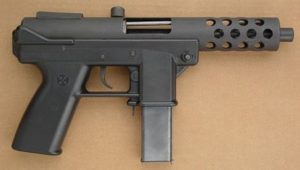More than 40 people were shot in Chicago last weekend, seven fatally, in what has become a grim Memorial Day ritual for the Windy City. Over the past three years, more than 150 Chicagoans have been shot over the three-day weekend that heralds the beginning of summer.
As in past years, the victims were mostly young men of color in their 20s. Two were shot within hours of each other on the same West Side block. The weapon used in one of those cases, a TEC-9 semi-automatic pistol, is resonant, and represents a repeating pattern.
The cheaply made firearm was introduced back in 1985, as the “crack era” in America’s inner cities was reaching its height. Easy to maintain and modify, it quickly became a favorite with drug gangs. By the 1990s the TEC-9 was so ubiquitous in US cities that I twice saw one being fired in Philadelphia’s Kensington neighborhood; on one occasion the bullets hit the ground a few feet from where I stood.

While drug violence fluctuates due to a variety of factors, the introduction of fentanyl and the disruption of structured distribution networks have led to an increase in shootings in US cities in recent years.
In the days leading up to Memorial Day weekend, the Chicago Police Department conducted a series of drug raids, arresting 32 people. According to the local CBS affiliate, it’s common for the CPD to conduct these raids before a big holiday weekend. But as I’ve written before in this column, these targeted sweeps often have unintended consequences.
Here in Philadelphia, increased police presence and several high-profile busts have also set everyone on edge. In the Latinx section of West Kensington, the anxiety was palpable during my visit there with a colleague last week. Young men who only a short time ago would have gladly answered my questions now kept their distance, quickly sharing a bottle of water or a cigarette before moving on without comment.
Earlier this year fatal shootings took out the owners of two of the area’s oldest drug blocks, leaving a power vacuum that is almost certain to cause more violence. Meanwhile, drug corners that were once thriving are now seemingly abandoned—or else will only serve known members of the local Latinx community.
More New Corners Than You Can Possibly Know
But don’t take that as any sign of victory against the illicit drug trade. The corners may be gone, but the product isn’t.
Two miles east, on a side street adjacent to the site of the former encampment dubbed “Emerald City,” more than a dozen people milled anxiously about, as lookouts kept an eye on a police cruiser sitting less than a block north. On a stoop a few feet away, a woman was tending to a fresh wound on the side of a man’s face.
Our presence was tolerated until someone noticed me silently shooting a photo. A woman approached and demanded that the image be erased, calling over two young men to make sure we knew she meant business.
Fortunately, dropping a few names of mutual acquaintances was enough to diffuse the situation, and the woman, Country, then agreed to sit for photos and an interview.
“I’m a ghost. I’m only seen when I want to be seen,” said Country. “This is my family, and I would go down for my family and take anyone else down for my family.”
Asked if the greater recent police presence has made it harder to find street drugs in Kensington, she smiled wryly.
“There are more new corners over here than you can possibly know.”

Photograph of Country by Christopher Moraff
Zero-Tolerance Drives Violence
And that is why the War on Drugs is a war on people. Law enforcement can harass, arrest, seize and intensify patrol efforts until whatever resources they have run dry, but only people will suffer. The drugs will keep on flowing; they just go somewhere else.
In Baltimore, where turf wars have similarly been fueling a surge in shootings, even the Drug Enforcement Administration can no longer ignore the obvious. Remarking on the effect of taking down so-called drug kingpins, Don Hibbert, an assistant special agent at the Baltimore’s division of the DEA, last week told a local news affiliate: “Unfortunately a lot of times you could end up seeing a level of violence might increase when you take a big group out like this one. These organizations, when they select a territory where they’re going to sell from, they don’t want other people coming in and selling drugs in their territory.”
The violence associated with zero-tolerance drug policy, too often overlooked in traditional harm reduction circles, is brutal and often senseless. In many cases, even killings not directly linked to the drug economy germinated in drug policy, and any comprehensive approach to the harms associated with drugs must include these harms.
Nor should we confine our analysis to the US. The global drug war has created a truly international killing field. In the Americas alone, we have just recently seen examples of this from the US-Mexico border down to Brazil.
An International Pattern
According to Brazilian press reports, more than 60 prisoners have been slaughtered since May 24 in an explosion of gang-related violence inside the country’s bursting prison system. In several cases victims were stabbed or strangled as they were receiving visits from family. A war between rival drug gangs, which effectively run Brazil’s prisons, reportedly sparked the murders.
Two recently released reports—one out of the University of San Diego’s Justice in Mexico program, and another from a group of Colombian think tanks known as Intepaz—provide more academic backing to a point that cannot be overemphasized: Police crackdowns on the illicit drug trade lead to more instability and death, not less. And violence driven by drug policy has claimed as many lives as drugs themselves, if not more.
According to the Justice in Mexico report, Mexico saw record violence in 2018, with 28,816 homicide cases encompassing 33,341 victims tallied by the Mexican National Security System (Sistema Nacional de Seguridad Pública).
“[V]iolence has become more pervasive throughout the country but remains highly concentrated in a few specific areas, especially in the major drug trafficking zones located in the northwest and the Pacific Coast,” the report states.
In some areas of Colima, a port city and key hub in the drug precursor trade, and Baja California, a primary trafficking route, murder rates have tripled since 2016.
Deaths and suffering caused by crackdowns are so consistent that adherence to these policies can only be construed as a willful embrace of these outcomes.
In Colombia, Indepaz (Institute of Studies for Development and Peace) lays blames on conservative president Ivan Duque’s stonewalling on a historic 2016 peace plan between the Colombian Government and rebel groups including FARC and the ELN (both of which rely on drug production to finance their decades long rebellions).
Indepaz estimates that Duque’s rejection of key tenets of the FARC peace deal—and his pandering to the DEA and the Trump administration in sticking with hardline drug policies—have contributed to the deaths of nearly 600 community leaders over the past several years. It’s also led to the killing of roughly 135 rebel (mostly FARC) officials.
“The existence of strong criminal organizations does not necessarily indicate high levels of violence,” notes Indepaz. “Criminal organizations control the use of violence to avoid the government focus on them. Needless to say, a very wealthy drug trafficker cannot enjoy his money in the cemetery. It is only when those controls weaken because the structure of the organization changes or when the organization itself decides to fight the state that violence erupts. These eruptions are particularly bloody and savage if the perpetrators are willing to use violence without regard to the consequences for society, or when they simply want to ‘hit where it hurts the most,’ that is, family members, children.”
At local, national and international levels, the deaths and suffering caused by drug-war crackdowns are so consistent and so well-established that adherence to these policies can only be construed as a willful embrace of these outcomes.
Top photo by Julian Böck on Unsplash




